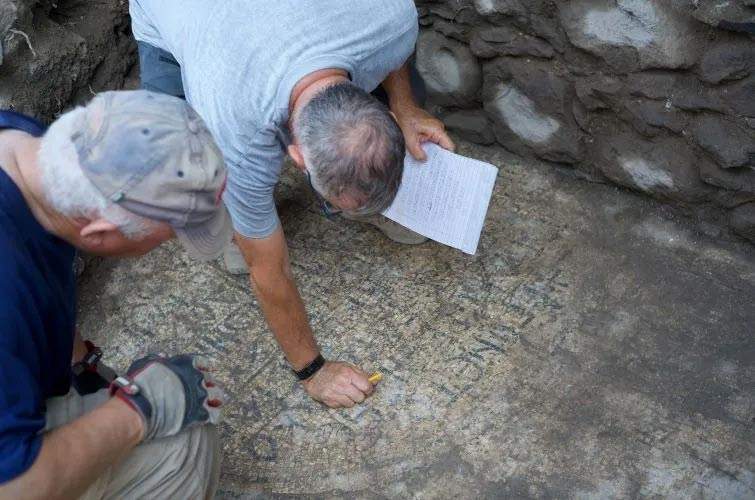Archaeologists from Kinneret College (Galilee, Israel) and Nyack College (New York, USA) led by Professors Mordechai Aviam and Steven Notley, respectively, during an excavation at the archaeological site of Beit Habek/El Araj, which is believed to stand on the ruins of the biblical town of Bethsaida, i.e., that which according to the Gospel of John was the birthplace of the apostles Peter, Andrew and John, discovered an inscription that would allow one to trace the place where St. Peter was born.
The inscription was discovered during excavations of an ancient Byzantine basilica, the Church of the Apostles, which at this point is believed to have been built on the site where the home of the apostles Peter and Andrew once stood. The inscription, in Greek, was translated by professors Leah Di Segni (Hebrew University) and Yaakov Ashkenazi (Kinneret College): it refers to a donor, “Constantine, servant of Christ,” and continues with a request for intercession from St. Peter, “head and commander of the heavenly apostles.” Framed by a round medallion formed by two rows of black tiles, the inscription is part of a larger mosaic floor in the church sacristy, partly decorated with floral motifs.
The title “chief and commander of the apostles” is customarily used by Byzantine Christian writers to refer to the apostle Peter. “This discovery,” confirmed Steven Notley, "is our strongest indicator that Peter had a special association with the basilica, and it was probably dedicated to him. Since Byzantine Christian tradition routinely identified Peter’s home in Bethsaida, and not Capernaum as is often thought today, it seems likely that the basilica commemorates his home. The discovery also reinforces the identification of the basilica with the church described by Bishop Willibald of Eichstätt in the 8th century: the prelate reported that it was built over the house of Peter and Andrew.
“One of the goals of this excavation was to see if there was a first-century stratification at the site, which will allow us to suggest a better candidate for the identification of the biblical Bethsaida,” says Mordechai Aviam. “Not only did we find significant remains from this period, but we also found this important church and the monastery around it.” The Roman remains that have been excavated attest to Flavius Josephus’ testimony that the village became a small polis called Julias, which existed until the third century CE. Taken together, these finds continue to reinforce the identification of Beit Habek/El Araj with the ancient Jewish village of Bethsaida.
The Beit Habek/El Araj site is located in the Beteiha Nature Reserve and assistance for the excavation operations was provided by the Israel National Parks Authority. The El Araj Exc avation Project is being conducted by the Kinneret Institute for Galilee Archaeology at Kinneret College and Nyack College. The excavation is sponsored by the Center for the Study of Ancient Judaism and Christian Origins (CSAJCO), the Museum of the Bible, Lanier Theological Library Foundation and HaDavar Yeshiva (HK). Excavations will resume in October, when cleaning of the entire church will be completed, with the goal of answering questions about its various construction phases and perhaps uncovering additional inscriptions. Students from Kinneret College as well as volunteers from the United States, Canada, Hong Kong, Slovakia, Brazil and the United Kingdom have participated in the excavations. Efforts focused on the area in and around the church, which was called during the excavations “the Church of the Apostles,” because of Willibald’s description of his pilgrimage to the Holy Land. On the journey from Capernaum to Kursi, the bishop stayed overnight at a place he was told was the biblical Bethsaida “where Peter and Andrew came from. Now there is a church where their house used to be.”
Pictured: Notley and Aviam above the inscription
 |
| Israel, archaeologists believe they have discovered site of apostle Peter's house |
Warning: the translation into English of the original Italian article was created using automatic tools. We undertake to review all articles, but we do not guarantee the total absence of inaccuracies in the translation due to the program. You can find the original by clicking on the ITA button. If you find any mistake,please contact us.